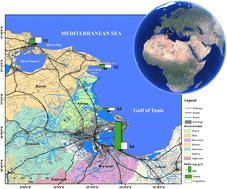Microplastic-sorbed persistent organic pollutants in coastal Mediterranean Sea areas of Tunisia†
Abstract
Microplastics (MPs) are emerging pollutants of global concern due to their pervasiveness, high sorption ability for persistent organic pollutants (POPs) and direct and indirect toxicity to marine organisms, ecosystems, as well as humans. As one of the major coastal interfaces, beaches are considered among the most affected ecosystems by MPs pollution. The morphological characteristics of MPs (pellets and fragments) collected from four beaches along the Tunisian coast and sorbed POPs, including polychlorinated biphenyls (PCBs) and organochlorine pesticides (OCPs), were investigated in this study. The results showed that the MPs varied greatly in color, polymer composition and degradation degree. The color varied from colored to transparent and the most prevalent polymer identified using Raman spectroscopy was polyethylene. Scanning electron microscope (SEM) images exhibited various surface degradation features including cavities, cracks, attached diatom remains, etc. The concentrations of Σ12PCBs over all beaches ranged from 14 to 632 ng g−1 and 26 to 112 ng g−1 in the pellets and fragments, respectively, with a notable presence and dominance of highly-chlorinated PCBs such as CB-153 and -138. Among the OCPs, γ-HCH is the only compound detected with concentrations ranging from 0.4 to 9.7 ng g−1 and 0.7 to 4.2 ng g−1 in the pellets and fragments, respectively. Our findings indicate that MPs found on the Tunisian coast may pose a chemical risk to marine organisms as the concentrations of PCBs and γ-HCH in most of the analysed samples exceeded the sediment-quality guidelines (SQG), especially the effects range medium (ERM) and the probable effects level (PEL). As the first report of its kind, the information gathered in this study can serve as the baseline and starting point for future monitoring work for Tunisia and neighbouring countries, as well as for stakeholders and coastal managers in decision-making processes.

- This article is part of the themed collection: Contaminant remediation and fate


 Please wait while we load your content...
Please wait while we load your content...